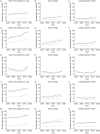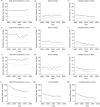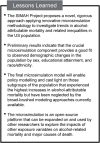Simulation of Alcohol Control Policies for Health Equity (SIMAH) Project: Study Design and First Results
- PMID: 36702471
- PMCID: PMC10423629
- DOI: 10.1093/aje/kwad018
Simulation of Alcohol Control Policies for Health Equity (SIMAH) Project: Study Design and First Results
Abstract
Since about 2010, life expectancy at birth in the United States has stagnated and begun to decline, with concurrent increases in the socioeconomic divide in life expectancy. The Simulation of Alcohol Control Policies for Health Equity (SIMAH) Project uses a novel microsimulation approach to investigate the extent to which alcohol use, socioeconomic status (SES), and race/ethnicity contribute to unequal developments in US life expectancy and how alcohol control interventions could reduce such inequalities. Representative, secondary data from several sources will be integrated into one coherent, dynamic microsimulation to model life-course changes in SES and alcohol use and cause-specific mortality attributable to alcohol use by SES, race/ethnicity, age, and sex. Markov models will be used to inform transition intensities between levels of SES and drinking patterns. The model will be used to compare a baseline scenario with multiple counterfactual intervention scenarios. The preliminary results indicate that the crucial microsimulation component provides a good fit to observed demographic changes in the population, providing a robust baseline model for further simulation work. By demonstrating the feasibility of this novel approach, the SIMAH Project promises to offer superior integration of relevant empirical evidence to inform public health policy for a more equitable future.
Keywords: alcohol policy; alcohol use; health equity; health policy; life expectancy; microsimulation; population health modeling; socioeconomic status.
© The Author(s) 2023. Published by Oxford University Press on behalf of the Johns Hopkins Bloomberg School of Public Health. All rights reserved. For permissions, please e-mail: journals.permissions@oup.com.
Figures






Similar articles
-
Alternative projections of mortality and disability by cause 1990-2020: Global Burden of Disease Study.Lancet. 1997 May 24;349(9064):1498-504. doi: 10.1016/S0140-6736(96)07492-2. Lancet. 1997. PMID: 9167458
-
The socioeconomic profile of alcohol-attributable mortality in South Africa: a modelling study.BMC Med. 2018 Jun 25;16(1):97. doi: 10.1186/s12916-018-1080-0. BMC Med. 2018. PMID: 29936909 Free PMC article.
-
Alcohol-Attributable Deaths Help Drive Growing Socioeconomic Inequalities In US Life Expectancy, 2000-18.Health Aff (Millwood). 2022 Aug;41(8):1160-1168. doi: 10.1377/hlthaff.2021.01905. Health Aff (Millwood). 2022. PMID: 35914205 Free PMC article.
-
Health inequalities: trends, progress, and policy.Annu Rev Public Health. 2012 Apr;33:7-40. doi: 10.1146/annurev-publhealth-031811-124658. Epub 2012 Jan 6. Annu Rev Public Health. 2012. PMID: 22224876 Free PMC article. Review.
-
The role of alcohol use and drinking patterns in socioeconomic inequalities in mortality: a systematic review.Lancet Public Health. 2020 Jun;5(6):e324-e332. doi: 10.1016/S2468-2667(20)30052-9. Lancet Public Health. 2020. PMID: 32504585
Cited by
-
Behavioral stability of alcohol consumption and socio-demographic correlates of change among a nationally representative cohort of US adults.Addiction. 2023 Jan;118(1):61-70. doi: 10.1111/add.16024. Epub 2022 Aug 28. Addiction. 2023. PMID: 35975709 Free PMC article.
References
-
- Basu S, Wagner RG, Sewpaul R, et al. Implications of scaling up cardiovascular disease treatment in South Africa: a microsimulation and cost-effectiveness analysis. Lancet Glob Health. 2019;7(2):e270–e280. - PubMed
-
- Basu S, Yudkin JS, Kehlenbrink S, et al. Estimation of global insulin use for type 2 diabetes, 2018–30: a microsimulation analysis. Lancet Diabetes Endocrinol. 2019;7(1):25–33. - PubMed
-
- Julien J, Ayer T, Bethea ED, et al. Projected prevalence and mortality associated with alcohol-related liver disease in the USA, 2019–40: a modelling study. Lancet Public Health. 2020;5(6):e316–e323. - PubMed

